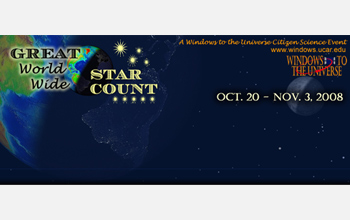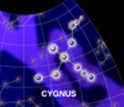|

Press Release 08-180
Star Count Goes Global

Light pollution to be mapped by thousands of citizen scientists this month
October 15, 2008
Schoolchildren, families and citizen scientists around the world will gaze skyward after dark from Oct. 20 to Nov.3, 2008, looking for specific constellations and then sharing their observations through the Internet. The Great World Wide Star Count, now in its second year, helps scientists map light pollution globally while educating participants about the stars. The event, which is open to everyone who wants to participate, is organized by the Windows to the Universe project at the University Corporation for Atmospheric Research (UCAR) in Boulder, Colo., in conjunction with planetariums and scientific societies across the country and abroad. Funding is provided by the National Science Foundation (NSF). "By searching for the same constellations in their respective hemispheres, participants in the Great World Wide Star Count will be able to compare their observations with what others see, giving them a sense of how star visibility varies from place to place," said Cliff Jacobs, program director in NSF's Division of Atmospheric Sciences. The observers will also learn more about the economic and geographic factors that control light pollution in their communities and around the world. "The star count brings families together to enjoy the night sky and become involved in science," says Dennis Ward of UCAR's Office of Education and Outreach. "It also raises awareness about the impact of artificial lighting on our ability to see the stars." The 2007 star count drew 6,624 observations taken in all seven continents, and organizers expect the number of participants to double this year. UCAR used last year's observations to generate maps of star visibility around the world. Next year, the star count will be part of a "cornerstone project" of the 2009 International Year of Astronomy, a global effort initiated by the International Astronomical Union and the U.N. Educational, Scientific, and Cultural Organization (UNESCO) to promote interest in astronomy. Participants in the Northern Hemisphere will look for the constellation Cygnus, while those in the Southern Hemisphere will look for the constellation Sagittarius. They will then match their observations with charts downloaded from the Great World Wide Star Count Web site. The site also contains instructions for finding the constellations, and other event details. Participants may make observations outside their homes or go to less-developed areas where more stars are visible. Those in overcast areas who cannot see stars will be able to input data about cloud conditions instead. Bright outdoor lighting at night is a growing problem for astronomical observing programs around the world. "Last year's results showed a strong correlation between dense development, where there is a lot of light, and a lack of star visibility," Ward says. "Without even being aware of it, many of us have lost the ability to see many stars at night. Part of our goal is getting people to look up and regain an appreciation of the night sky."
-NSF-

Media Contacts
Cheryl Dybas, NSF (703) 292-7734 cdybas@nsf.gov
David Hosansky, NCAR/UCAR (303) 497-8611 hosansky@ucar.edu
Related Websites
Great Worldwide Star Count: http://www.windows.ucar.edu/starcount

The National Science Foundation (NSF) is an independent federal agency that
supports fundamental research and education across all fields of science and
engineering, with an annual budget of $6.06 billion. NSF funds reach all 50
states through grants to over 1,900 universities and institutions. Each year,
NSF receives about 45,000 competitive requests for funding, and makes over
11,500 new funding awards. NSF also awards over $400 million in
professional and service contracts yearly.
 Get News Updates by Email Get News Updates by Email
Useful NSF Web Sites:
NSF Home Page: http://www.nsf.gov
NSF News: http://www.nsf.gov/news/
For the News Media: http://www.nsf.gov/news/newsroom.jsp
Science and Engineering Statistics: http://www.nsf.gov/statistics/
Awards Searches: http://www.nsf.gov/awardsearch/
| 


